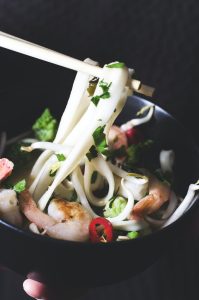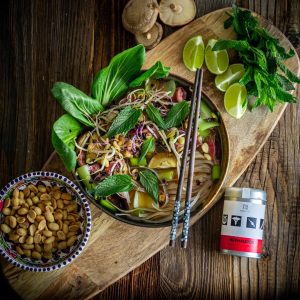Vietnamese cuisine is one of the most unique and diverse cuisines in the world. Vietnamese cuisine is known for its wide range of ingredients and flavors. It typically comprises five different elements: sweet, sour, salty, bitter, and spicy. The use of fresh herbs and vegetables is also important in Vietnamese cooking. It has been influenced by Chinese and French cuisines but maintains the unique flavor that makes it very popular among people around the world. The climate and geography of Vietnam have strongly affected the country’s cuisine. Most dishes are prepared with minimal fat and oil, so they’re low in fat and high in protein. Traditional Vietnamese cuisine is believed to contain less saturated fats than other types of diets such as Japanese, Chinese or Thai cuisine.
The most well-known Vietnamese street foods are pho (rice noodles in broth), bun cha (barbecued pork patties served with rice vermicelli and herbs), banh mi (baguettes filled with meats or vegetables), and cha gio (fried egg rolls).
Craving to try mouthwatering Vietnamese street foods? You don’t need to travel the world to taste these delectable traditional Vietnamese dishes. At the heart of Metro Manila is Em Ha Noi, a restaurant that serves authentic Vietnamese street food that’s good for the heart and tummy, and also has value for your money. It’s a Vietnamese experience!
Condiments are essential to the Vietnamese dining experience.
The Vietnamese dining experience is also characterized by a plethora of condiments. They help enhance the flavor of food while also providing extra dipping sauce for those who want to take their meal from good to great.
Condiment options include fish sauce (nuoc mam), soy sauce (tam sua), vinegar (cach su do), or lime juice (muoi tieu). Fish sauce has been an essential part of the Vietnamese diet since at least 1000 BC when it was made by boiling salted anchovies in water until the liquid turned into oil. The oils were then used for cooking or as a flavoring agent for other foods like meat or vegetables. Today’s methods have changed since ancient times but the fish sauce still plays an important role in Vietnamese cuisine today with many people using it on almost every meal they eat! This gives them a unique taste compared to other Southeast Asian nations.
Fish sauce is pervasive in Vietnamese cooking: it’s on almost every table and used as a dipping sauce for steamed vegetables, fried fish, and meat. It is also used as an ingredient in soups, stews, stir-fries, and sometimes even desserts.
A Bowl of Rice is a must!
Rice is the main staple of Vietnamese cuisine. You can find it served with almost every dish, often as a side dish called cơm tấm or broken rice. The most popular type of rice is jasmine rice but you’ll also find black sticky rice and glutinous sticky rice used in many dishes as well.
Vietnamese people eat rice in one of two ways: dry or sticky. The dry rice is served in individual bowls, with other food dishes arranged on a shared platter. Sticky rice is most often eaten on its own, without the addition of vegetables or other seasonings. To maintain a moist texture and prevent clumping during cooking, sticky rice is usually steamed before being served.
North, Central, to South, the dishes are never the same, representing the soul of each region, and the locals’ way of life.
When visiting Vietnam, it’s a must for every tourist to taste the local street food. When you sit down at a table and eat the local food, you get to watch life as it passes by. That is the most authentic dining experience. In Em Ha Noi, though situated in Metro Manila, you can relish authentic Vietnamese street food and culture through their diverse menu filled with dishes from North, Central, and South Vietnam.
Vietnamese cuisine has been divided into three areas: North, Central, and South. The dishes are never the same in terms of ingredients, tastes, and flavors. Each region has a culture that is reflected in its recipes.
The first thing you might notice about Vietnamese food is its simplicity: many dishes are prepared simply without much fuss or complicated cooking methods. They often feature fresh ingredients like herbs and vegetables which add flavor without overpowering other elements in the dish.
Northern Vietnam Cuisine
Northern Vietnamese cuisine is known for its use of fresh herbs and spices, including mint, cilantro, basil, and more. In this region, the flavors are often very light and subtle, with a focus on seafood. The recipes of traditional Northern dishes are rarely altered but strictly adhere to the recipes passed down from ancestors. A single dish can have many variations, depending on the ingredients and cooking methods used.
Here are some of our favorite Traditional Northern Vietnamese dishes in Em Ha Noi:
- Pho:
A Vietnamese noodle soup containing thinly sliced beef or chicken and vegetables in broth with rice noodles or egg noodles served with basil, cilantro, and sprouts on the side for toppings. Beef pho was created in northern Vietnam during the colonial period when meat was scarce. It’s now considered one of Vietnam’s national dishes!
- Bun Cha:
This delicious dish is made with rice noodles as its main ingredient and grilled pork served on the side. The smoky, aromatic flavor of the pork blends remarkably well with this sweet-sour sauce—and fresh herbs add a pop of color and flavor.
- Spring Roll – Nem Ran (Deep Fried) or Goi Cuon (Fresh):
A crowd-favorite, spring rolls are made with a seasoned ground-meat mixture and diced vegetables, rolled up in rice paper that is either deep-fried or served fresh. Inside the crunchy rice papers is a juicy blend of textures and flavors. Spring rolls are often dipped in a sweet-sour sauce, topped with fresh herbs, and served over rice noodles.
Central Vietnam Cuisine
The Central region is known for its imperial cuisine. The dishes are very sophisticated and require a lot of ingredients, but the flavors are well-balanced. This region has the harshest weather, with many storms and floods in summer as well as monsoon rains. So people prefer spicy dishes to keep them warm. If you want to know what this type of food tastes like, think about Chinese imperial cuisine and other types of royal cuisines from around Asia, which typically use lots of spices, sauces (such as curry), and marinated meats. Dishes are also typically served in smaller portions.
In Em Ha Noi, you can enjoy Bun Bo Hue, a popular Central Vietnamese Cuisine meant to tickle your tastebuds:
- Bun Bo Hue:
The dish was created in Hue, a city in central Vietnam traditionally associated with the cooking style of the former royal court. The blend of spicy, salty, and umami flavors makes it unique among Vietnamese dishes. The broth is made from lemongrass, shrimp paste, sugar, and chili oil. It’s poured over noodles with beef shank and pig’s knuckles. Congealed pig blood cubes are added next along with crab sausage pieces.
Southern Vietnamese Cuisine
French cuisine had a profound influence on the eating habits of people in Indochina during their colonial period. For instance, Banh Mi is a Vietnamese sandwich that has been influenced by the French baguette. While the food in the north of Vietnam tends to be mild and plain, people living in the south enjoy more flavorful dishes with strong flavors—especially spicier foods. They use pure fish sauce, and hot chili peppers to spice up their dishes. People in this region have tweaked recipes that come from other regions to suit their tastes. Their dishes are also known for their sweeter flavor profile than other regions of Vietnam which makes it popular with both locals and foreigners alike.
Many items are made with more coconut milk, fish sauce, or lemongrass than other regions of Vietnam to give them a unique taste that is less salty than Northern Vietnamese cuisine but still packs a punch with its spicy kick!
Our favorite Southern Vietnamese dishes are also served in Em Ha Noi!
- Ca Loc Nuong:
Grilled snakehead is one of the most popular dishes in Southern Vietnam with a unique flavor and simple method of cooking. Snakehead is not processed or added any ingredients before grilling. The hot grilled snakehead is usually served with rice paper and vegetables, along with the sweet and sour fish sauce.
- Banh mi:
This is a popular snack eaten throughout Southeast Asia but especially popular among the Vietnamese people themselves! A baguette filled with chicken pate or pork belly, fresh herbs such as cilantro leaves or basil then drizzled in sriracha sauce before being wrapped up tight in paper.
Vietnamese food is not only food but is Vietnamese culture.
Vietnamese cuisine is one of the most popular Asian cuisines. It is known for its delicious soups and noodles. The best part about these dishes is that they can be served as breakfast, lunch, or dinner. It has something for everyone, whether you are a meat lover or vegetarian. You can find many different types of pho, banh mi, and other Vietnamese dishes in restaurants all across the world. Traveling to Vietnam with family and friends is a great idea to experience the culture of the country. But, if you find yourself craving Vietnamese food in the middle of the day or just to cap off a nice day outside, drop by Em Ha Noi to experience the authentic Vietnamese food the place has to offer.





